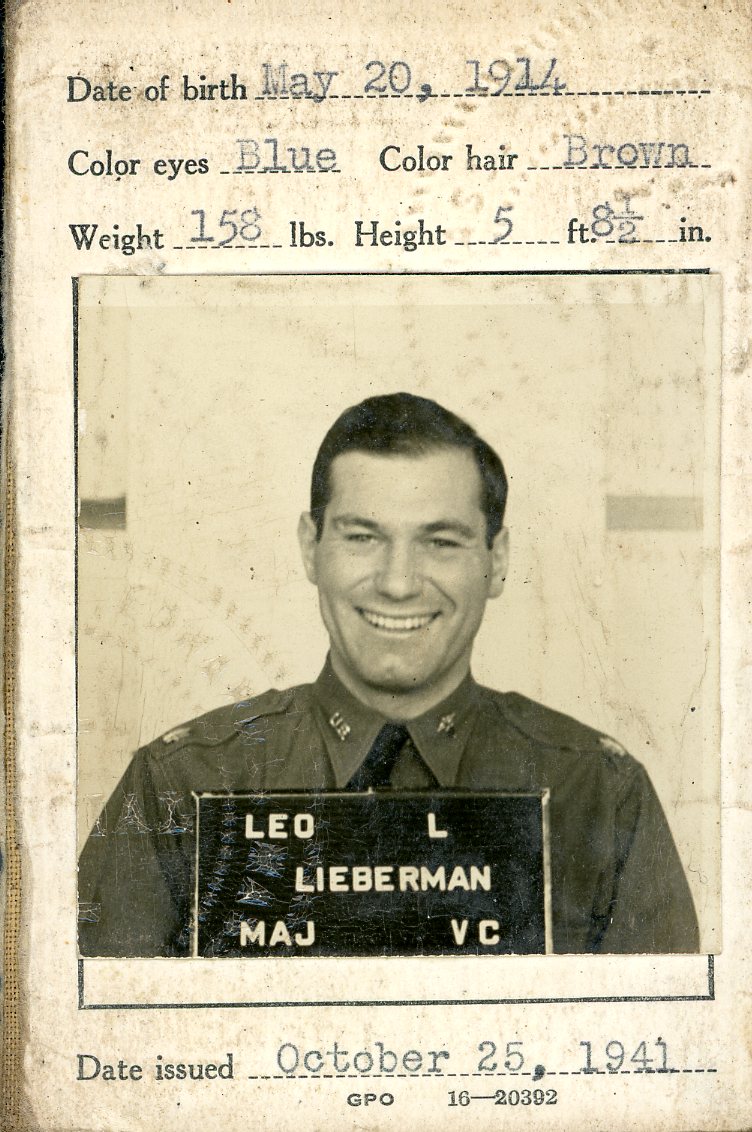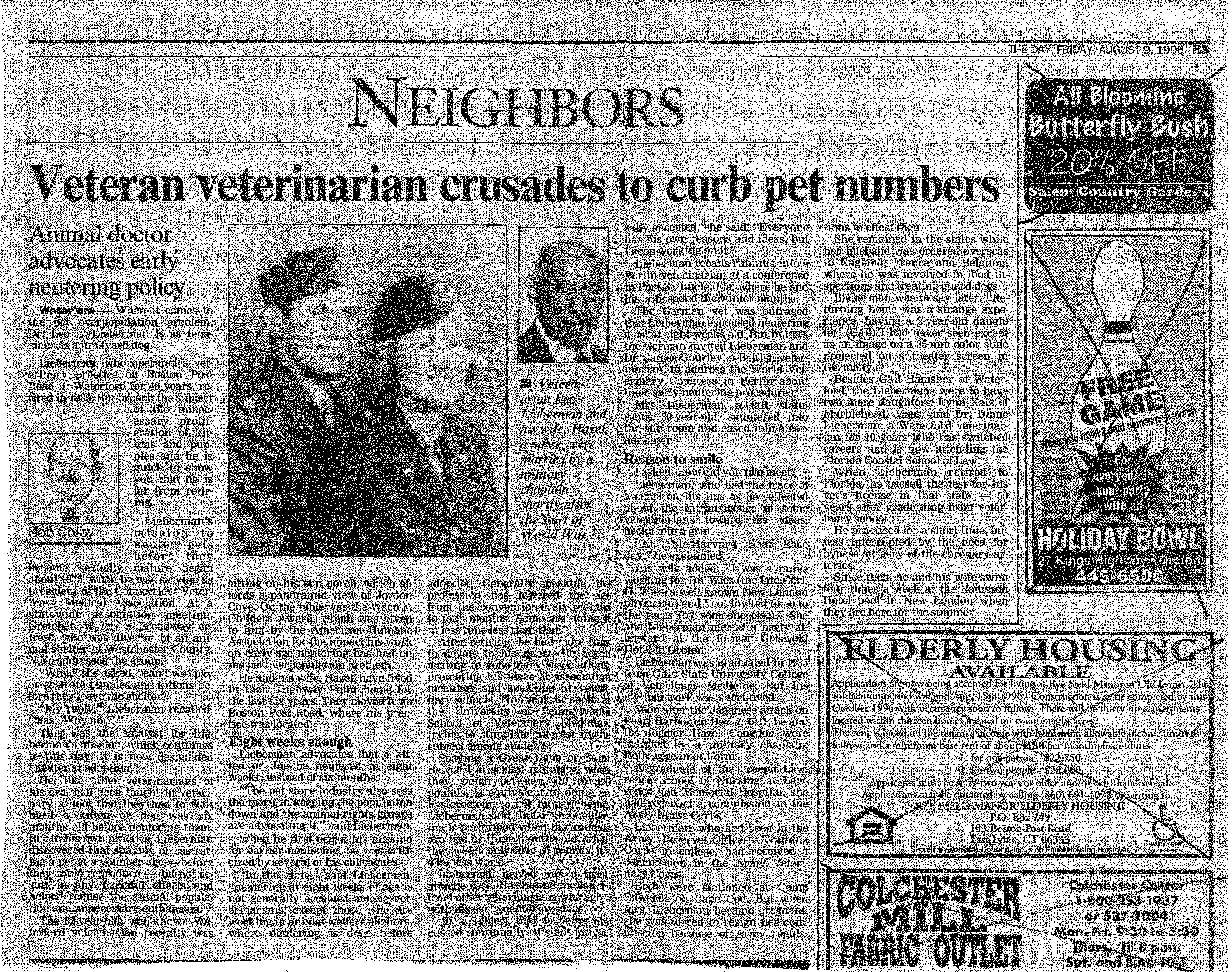
Lieberman’s prototype for “I (Spayed) My Dog” bumper sticker to advertise clinic services (Box 21, Folder 4).

Lieberman’s prototype for “I (Spayed) My Dog” bumper sticker to advertise clinic services (Box 21, Folder 4).
This blog post contributed by Katie Bushman, Special Collections Graduate Desk Assistant.
The Libraries’ Special Collections Research Center is pleased to announce that the collection guide for the newly processed Leo L. Lieberman Papers is now available online. Lieberman was a pioneer of the practice of early neutering, advocating that all puppies and kittens should be spayed or neutered before adoption in order to prevent pet overpopulation.

The collection contains Lieberman's personal and professional papers from circa 1918 to 2004, including correspondence, personal and professional records, video cassettes, slides, journal articles, newspaper and magazine articles, collected publications, and administrative records.
The child of Austrian Jewish immigrants, Leo Leibsch Lieberman was born in Connecticut on May 20, 1914. After graduating with a Doctorate in Veterinary Medicine from Ohio State University in 1935, he became the youngest First Lieutenant in the United States Veterinary Corps. While stationed in New London, Connecticut, he met Army nurse Hazel Congdon. After Pearl Harbor was attacked and the United States entered World War Two in 1941, Leo and Hazel were married in uniform by a military chaplain. Shortly afterward, Lieberman was sent with the Veterinary Corps to Europe, where he was responsible for inspecting and managing food supplies for combatants. Hazel served as a Second Lieutenant Army Nurse in the Army Nurse Corps until she became pregnant and had to resign her commission, due to Army regulations at the time, in October 1942.
Following the war, Lieberman opened a private veterinary practice in Waterford, Connecticut, which he operated for 30 years. He joined the Connecticut Veterinary Medical Association (CVMA) and later served as its president.

During his tenure as president of the CVMA in the 1970s Lieberman first became interested in the issue of early neutering. At a CVMA meeting discussing the issue of pet overpopulation, Broadway actress and animal rights activist Gretchen Wyler asked why puppies and kittens couldn’t simply be spayed or neutered before they left the shelter. In an American Veterinary Medical Association (AVMA) reflection article, Lieberman recalled replying, “Why not?”
Lieberman began researching the issue and found a surprising lack of research on the feasibility of neutering puppies and kittens before the standard age of six months. He soon found that the tendency to spay and neuter animals at a larger age was based on a tradition from the 1920s when the anesthetic and surgical technology of the time made it dangerous to operate on small animals. By the 1970s, these technologies had improved to allow doctors to perform spay/neuter surgeries on animals eight to ten weeks old with a wide margin of safety. Lieberman began performing the surgeries on animals as young as eight weeks old and found it extremely safe and feasible.


While many shelters required owners adopting pets as young as eight weeks old to have them spayed and neutered at six months, these policies were often not put into practice. The Animal Rescue League of Boston calculated that if a single unspayed cat or dog had two litters per year, and two kittens or puppies survived from each litter to reproduce and were also never spayed, the descendants of this single animal could exponentially multiply to 59,000 animals in just five years. The issue of pet overpopulation led to the euthanization of millions of animals per year in the United States.
After retiring from his veterinary practice in 1986, Lieberman turned his full attention to his advocacy efforts. Because tradition for so long had held that early neutering was unsuitable, many critics were skeptical about the safety of the procedure and its long-term effects. Lieberman set out to prove that the procedure was safe. He partnered with researchers from the University of Florida to conduct a long-term study of the effects of early neutering, published in the Journal of the American Veterinary Medical Association in 1991, that found that neutering at eight weeks had no adverse effects on long-term pet health.
Lieberman’s advocacy work culminated in 1993, when the AVMA House of Delegates passed a resolution endorsing the early-age neutering of pets before adoption. While it was still up to members whether they chose to follow the resolution, this marked a significant shift in favor of neuter-before-adoption and a milestone in the crusade against pet overpopulation.

Lieberman continued to advocate for neuter-before-adoption until he passed away on February 15, 2006 at the age of 91.
If you have any questions or are interested in viewing Special Collections materials, please contact us at library_specialcollections@ncsu.edu or submit a request online. The Special Collections Research Center is open by appointment only. Appointments are available Monday–Friday, 9am–6pm and Saturday, 1pm–5pm. Requests for a Saturday appointment must be received no later than Tuesday of the same week.